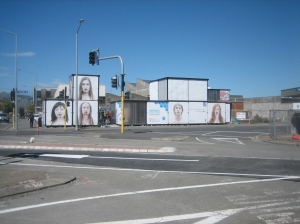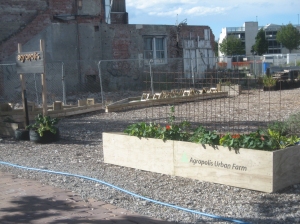By Dr Andreas Wesener, Lecturer in Urban Design at the School of Landscape Architecture
Transitional Community-initiated open spaces (CIOS) have emerged in the wake of the 2010/2011 earthquakes on post-earthquake vacant sites in Christchurch with a diverse range of uses. The number of people and organisations involved suggest that local communities place a high value on CIOS. In October 2014, the International Congress on Adaptive Urbanism, organised by community activists and academics in Christchurch, discussed how the creative energy of temporary projects and bottom-up governance approaches could be turned into strategies for sustainable urban development. Lincoln University researchers support community organisations in Christchurch in their endeavours to create distinctive, viable, high-quality public open spaces.
Creative temporary or transitional uses of vacant urban spaces are seldom foreseen in traditional urban planning and have historically been linked to economic or political disturbances. Christchurch, like most cities, has had a relatively small stock of vacant spaces throughout much of its history with car-parking as the default interim use. This changed dramatically after the city was hit by several devastating earthquakes in 2010 and 2011. Parallel to the ‘official’ rebuild discourse, temporary uses have emerged on dozens of vacant post-earthquake sites. Transitional community-initiated open spaces (CIOS) have been developed by various local community groups as bottom-up initiatives including community gardens, urban agriculture, art installations, event venues, eateries, cafés and pocket parks. The groups rely on financial sponsorship, agreements with local landowners who leave their land for temporary projects until they are ready to redevelop, and volunteers who build and maintain the spaces. Two popular organisations emerged immediately after the September 2010 earthquake: ‘Greening the Rubble’ with a focus on ‘green’ landscape projects such as temporary public parks and gardens, and ‘Gap Filler’ which has advocated creative and experimental projects involving local artists, architects and designers. CIOS are not part of the top-down central government-led rebuild program for central Christchurch, but they have received official endorsement, public funding and international media coverage. There is evidence that people’s participation in temporary projects has encouraged positive emotions and creativity, strengthened social capital and fostered community empowerment within a challenging post-disaster situation.
In October 2014, more than 70 individuals from various disciplinary and geographical backgrounds were invited to participate in the International Congress on Adaptive Urbanism in Christchurch[1]. Organised by local community activists and academics and sponsored by various organisations including Lincoln University, the congress discussed how the creative energy of temporary projects and bottom-up governance approaches could be turned into long-term strategies for sustainable urban development – in Christchurch and other places. This important discussion concerns the raison d’être of the various post-earthquake grassroots initiatives. It also raises the question of how public participation in urban planning and design could be reformed in order to give community groups a stronger voice in urban development processes. The congress organisers related the term ‘adaptive urbanism’ to bottom-up creation, utilisation and governance of temporary public open spaces. However, congress participants seemed rather reluctant to define ‘adaptive urbanism’ and link it to a few catch-phrases. In his essay ‘Short Guide to 60 of the Newest Urbanism’, published in the April 2011 issue of ‘Planning’, the member magazine of the American Planning Association, Jonathan Barnett convincingly argued that there has been an inflationary number of ‘new’ urbanisms popping up in recent years. This raises the question if another urbanism is needed to describe what is going on in Christchurch and in other places around the world; if grassroots initiatives need branding strategies to pronounce their opposition to top-down urban planning practice. Community initiatives may prevail if temporary projects possess distinctive creative and functional qualities and the viability to be supported by many and various people. European case studies show that communities have been able to sustain in conflict situations with unequal power structures by transforming transitional concepts into permanent schemes accompanied by occasional setbacks caused by conflicting interests. Community organisations that are able to develop and communicate convincing arguments about the long-term benefits of their projects might keep a noteworthy voice within Christchurch’s dynamic urban development process after the post-disaster recovery phase.
Key informant interviews with CIOS facilitators revealed that neither community organisations nor local authorities such as Christchurch City Council – one of the main funders of temporary projects – have had sufficient capacities to carry out relevant research on the processes and products of the community organisations’ work. Lincoln University is dedicated to support community organisations in Christchurch through research. Researchers at the Faculty of Environment, Society and Design (ESD) including the School of Landscape Architecture are engaged in a cross-departmental research project with the aim to examine defining characteristics and qualities of transitional community-initiated open spaces, analyse the social networks that initiate and support these spaces, and evaluate the benefits of CIOS with a focus on what they actually deliver rather than what they symbolise for post-disaster recovery in Christchurch. The research project which started in 2013 is titled “Transitional community-initiated open spaces in Christchurch: a driver for post-disaster urban recovery?” and funded by an ESD collaborative research grant. It involves different studies which often run parallel and involve students’ work. A two-year graduate scholarship has been made available for a PhD student at the School of Landscape Architecture starting in January 2016.
NOTES: [1] http://www.adaptiveurbanism.org.nz/
This blog post relates to a paper which Andreas Wesener has just had published. You can read the paper HERE or you can access the Congress Report at: http://issuu.com/ryanreynolds1/docs/au_report_hr_spreads_a3

